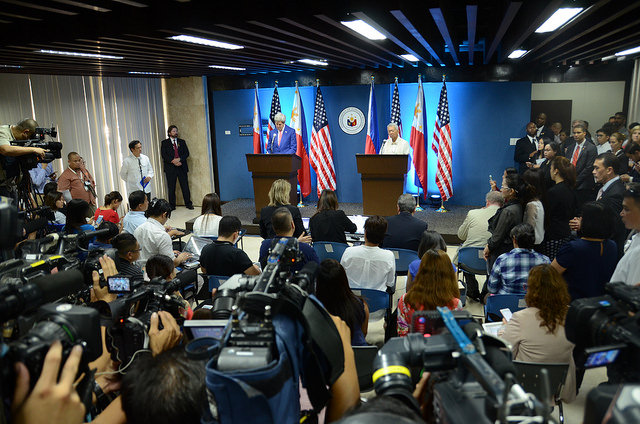PH-US defense relations
Amid the increasing tension in our region aggravated by the recent military exercises in the South China Sea of the United States and of China (to be joined by Russia in new military drills in September), and the visit of US Secretary of State John Kerry a few days ago, it is apropos to review our defense relations with America.
Three treaties. This relationship was highlighted in the decision penned by Chief Justice Maria Lourdes P.A. Sereno in Saguisag vs Ochoa (Jan. 12, 2016) which upheld the constitutionality of the Enhanced Defense Cooperation Agreement (Edca).
The United States colonized the Philippines after vanquishing the Spanish fleet in the Battle of Manila Bay in 1898. Under the Treaty of Paris concluded in the same year, Spain ceded the Philippines to the United States.
Concurrently with our “independence” on July 4, 1946, the two countries entered into the 1946 Treaty of General Relations, in which the United States relinquished control and sovereignty over the Philippines, except in the existing US military bases.
This treaty became the “mother” of our defense relationship with the United States. Pursuant thereto, three defense pacts were concluded: the 1947 Military Bases Agreement (MBA), the 1947 Military Assistance Agreement (MAA), and the 1951 Mutual Defense Treaty (MDT).
The MBA provided for the operation of 23 US military bases for 99 years or until 2046 and mandated further negotiations to allow the Americans to expand their existing bases or to acquire new ones.
MBA amendments. Over the years, the MBA was amended significantly: 1) Its term was reduced from 99 to 44 years or until 1991; 2) certain bases were returned to the Philippines; 3) Philippine sovereignty over the Clark and Subic bases was recognized and the areas therein that could be used by the US military was reduced; 4) the treaty was to be reviewed mandatorily every five years; and 5) the military bases were to be used by the United States within the context of Philippine sovereignty, including prior consultation for such use.
The MAA was not a treaty, but merely an executive agreement that established the conditions under which US military assistance would be granted, particularly the provision of military arms, ammunitions, supplies, equipment, vessels, services and training for our defense forces.
On Aug. 30, 1951, the MDT was entered into on the premise that an armed attack on either country would be a threat to the security of the other. The treaty has two main features: 1) mutual assistance in maintaining and developing the two countries’ individual and collective capacities to resist an armed aggression; and 2) mutual self-defense in the event of an armed attack against the “territory” of either party.
Due to the expected expiration of the MBA in 1991, the two countries negotiated a renewal of their defense and security arrangements. In a proposed treaty, they sought to extend the term of the US bases. But on Sept. 16, 1991, the Senate rejected the proposed treaty; hence, the United States relocated its forces.
This rejection by the Senate’s “Magnificent Twelve” satisfied Filipino nationalists but minimized America’s ability to project its power in the Western Pacific. The power vacuum gave China the opportunity to replace America as the dominant power in our region.
Despite the closure of the bases, the Philippines remained a staunch US ally, and they carried out joint military exercises throughout the 1990s. While large-scale joint military drills were suspended in 1995, the two countries later agreed to resume these albeit at a substantially reduced level.
VFA and Edca. A more intensified alliance was formally revived in the late 1990s resulting in the conclusion of the Visiting Forces Agreement (VFA) on May 27, 1999. The Supreme Court upheld the constitutionality of this treaty in Bayan vs Zamora (Oct. 10, 2000).
The VFA governs the treatment of US military and civilian personnel visiting the country. A counterpart agreement (VFA II) regulates the treatment of Philippine military and civilian personnel visiting the United States.
After the terrorist attack on the World Trade Center in New York City on Sept. 11, 2001, PH-US defense relations entered a new phase, principally with US forces helping combat an al-Qaida-linked insurgency in the South.
In January 2002, US military and civilian personnel started arriving in Mindanao to take part in the Balikatan, simulating joint military maneuvers in case of an armed attack.
In the same year, the two countries entered into the Mutual Logistics Support Agreement outlining the basic terms, conditions and procedures for the reciprocal provision of logistics support, supplies and services between their military forces. It has been extended twice and will last until 2017.
In 2013, the Philippines filed an arbitration case after China occupied Scarborough Shoal off the coast of Zambales. This coincided with US President Barack Obama’s “pivot to Asia” policy. After eight rounds of negotiations amid heightening tension between China and its neighbors around the South China Sea, the two countries signed the Edca.
This agreement expands US access to Philippine bases on a rotational basis and provides for America’s construction of new facilities as well as the prepositioning of defense equipment. It authorizes US access to some “agreed locations” in the country and to conduct certain activities therein.
In the context of the foregoing review, will our defense pacts with the United States help or hinder us in addressing our concerns in the South China Sea? This question deserves an answer next Sunday. Abangan.
* * *
Comments to chiefjusticepanganiban@hotmail.com.
RELATED VIDEO





















